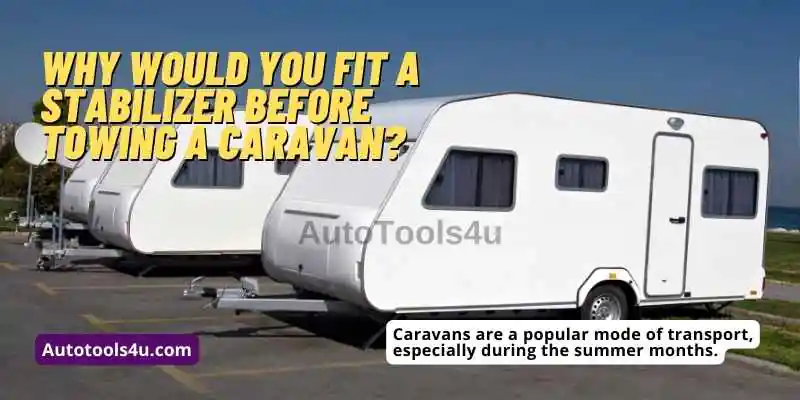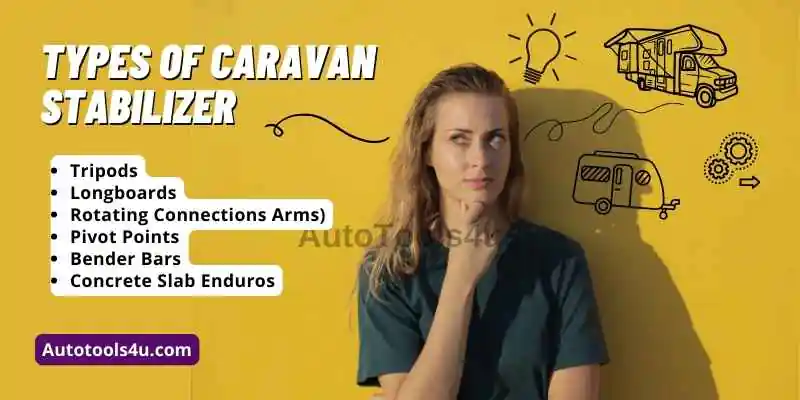If you’re an avid caravan enthusiast, then you know how important it is to keep your vehicle stable on the road. Caravan stabilizers are designed to do just that – keep your caravan from swaying, bouncing, or tipping over while you’re driving. The last thing you want is to feel like you’re on a roller coaster ride every time you hit a bump or turn a corner. That’s why investing in a good set of caravan stabilizers is essential for any caravanner who wants to stay safe and comfortable on the road. In this article, we’ll explore the benefits of using caravan stabilizers, how they work, and what to look for when choosing the right ones for your caravan. Whether you’re a seasoned caravanner or just starting out, this guide will help you stay steady on the road and enjoy a smooth and safe driving experience.
A caravan stabilizer is a device used to hold caravans upright in windy conditions when the caravan is unhitched or the vehicle carriers are removed. The brackets and plates offer additional support to ensure that the caravan remains sturdy on its wheels.
Caravan stabilizers are a great addition for anyone who owns a caravan and needs to travel. By using this device, you would not find yourself having to struggle with your vehicle just for a quick trip out of town or even for an overnight stay.
Why would you fit a stabilizer before towing a caravan? 
Caravans are a popular mode of transport, especially during the summer months. They’re convenient and cost-effective, and they provide a great way to explore the countryside. But there is one downside that comes along with owning a caravan; not having to worry about all the bumps in the road when you hit them on your journey. But there are times when it is worth fitting a stabilizer before towing your caravan behind your car or truck.
Stabilizers help reduce damage from vehicle collisions and increase stability during transport. It’s best to fit one after carrying out basic checks on your caravan, such as checking for any loose fittings or leaks in tyres etc.
Types of Caravan Stabilizers
One of the most common tools to stabilize a caravan, a longboard, or other heavy equipment is a stabilizer bar. They are used in construction, transportation, and engineering. Caravan stabilizers work on the same principle but are designed to support more weight than a simple plank or beam. There are many different types that can be used in different situations and environments.
Eight types of caravan stabilizers:
- Tripods
- Longboards
- Rotating Connections Arms & Spoked Arms (e.g. Wilson Spoke Arm)
- Pivot Points
- Bender Bars
- Concrete Slab Enduros (e.g.: Trakker)
How do caravan stabilizers work?
While caravans are structured to be stable on the road, the addition of a stabilizer can offer extra stability and damping, in case of wind or bad roads. There are two types of caravan stabilizers: those which function horizontally and vertically and others with lateral action only. The second one is widely used because of its simple operation style with its immediate hitching up and dry tow balls.
Hitched stabilizers need a dry tow ball and friction material, similar to the ones used in the brake linings. If correctly set, the friction pads have long service lives and replacement pads are available in the market, in case of wear. The major companies specializing in stabilizers are Al-Ko and BPW (Winterhoff) and they have a mechanical indicator to show when the hitch is safely engaged over the ball.
1) ATC (Active Trailer Control)
This is an anti-shake system made to stretch the caravan outfit by applying the brakes whenever the trailer starts to sway (yaw) beyond a certain limit. It monitors the caravan swing and if it detects that the movement is beyond the prescribed limit, it pulls the trailer brakes on, briefly to bring the caravan back into line. However, it doesn’t react to sudden movements which can be self-corrected or in narrow cornering.
2) Lateral and Horizontal function:
These types of stabilizers which have both functions have linkages to connect the trailer and the vehicle, on one side of the drawbar or both. The principles of these types of stabilizers operate with the single-leaf spring mounted on a friction pad. Example: Bulldog 200Q/300Q.
Benefits of using caravan stabilizers: 
A caravan stabilizer is not a necessary requirement but it doesn’t hurt to have it. Investing in a caravan stabilizer for your trailer is a wise choice. Sometimes, you may do all the needful but unprecedented circumstances on the road can cause certain damage to your trailer and this is where a caravan stabilizer comes to the aid. There are two types of unnecessary movements that are harmful to the caravan. They are:
- Pitching: This vertical movement happens when there is a low indentation in the road or a pothole.
- Yaw: This is a side-to-side movement, it happens because of strong gusts of wind.
If a stabilizer is used, then the types of unnecessary movements can be prevented. All caravans are equipped with good safety measures but a stabilizer grounds the safety more and if you equip your caravan with one, gusts of wind, the risk of instability in rough terrains, and high speeds and lower critical speed can be avoided.
Blade-type stabilizers:
They are affordable, easy to use and service helps in preventing yawing and pitching and can be transferred from one vehicle to the other, without much effort. However, a greased tow ball is required for its function and an A-frame fairing will require more modification and has to be fitted before each trip.
Towball-mounted stabilizers:
The pros of these stabilizers are that they don’t have to be stored away, increase critical speed and use a clean, dry towing ball. On the other hand, they are slightly expensive compared to blade-type stabilizers and use a special and unique hitch lock.
Active stability braking system:
This was introduced mainstream in the 2007s and is still a new concept. These systems are very helpful in controlling unnecessary movements in strong weather conditions. This system uses sensors and the status of the system is also displayed when it gets ready to be used.
Why do caravans snake?
This happens when the tow car and the caravan are out of sync and veer side to side like a snake. This happens because of sudden movements, crosswinds, and high speed. Snaking can cause severe accidents and causes disruption to other road users. To prevent snakes, good towing practice is the first that has to be followed. Loading your caravan correctly and making sure that the tire pressures are right, in both the tow car and the caravan helps prevent snaking.
Tips before buying a stabilizer:
- Make sure that the stabilizer that you are buying is compatible with your caravan.
- Choose substance over style.
- Keep a budget, so that you don’t go overboard.
- Research different types of stabilizers and choose accordingly.
- Ask about installation before purchasing, if it is your first time buying a stabilizer.
Tips while using a stabilizer:
- While using a stabilizer hitch, be sure to clean your tow ball.
- Before taking the reverse, it is best to remove the stabilizer.
- Blade stabilizers reduce ground clearance, so you should be on the lookout for humps or potholes.
A caravan stabilizer is not necessary but there are many advantages to it. For a safer ride, this can be a necessary addition.


